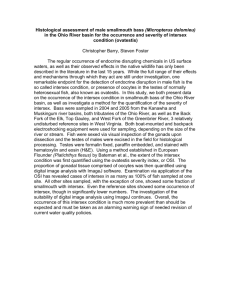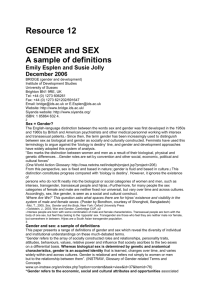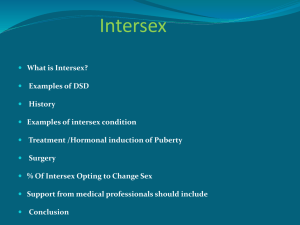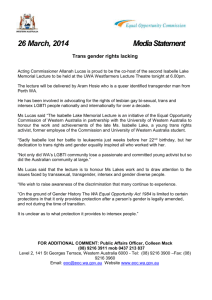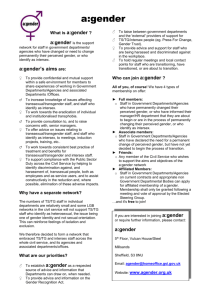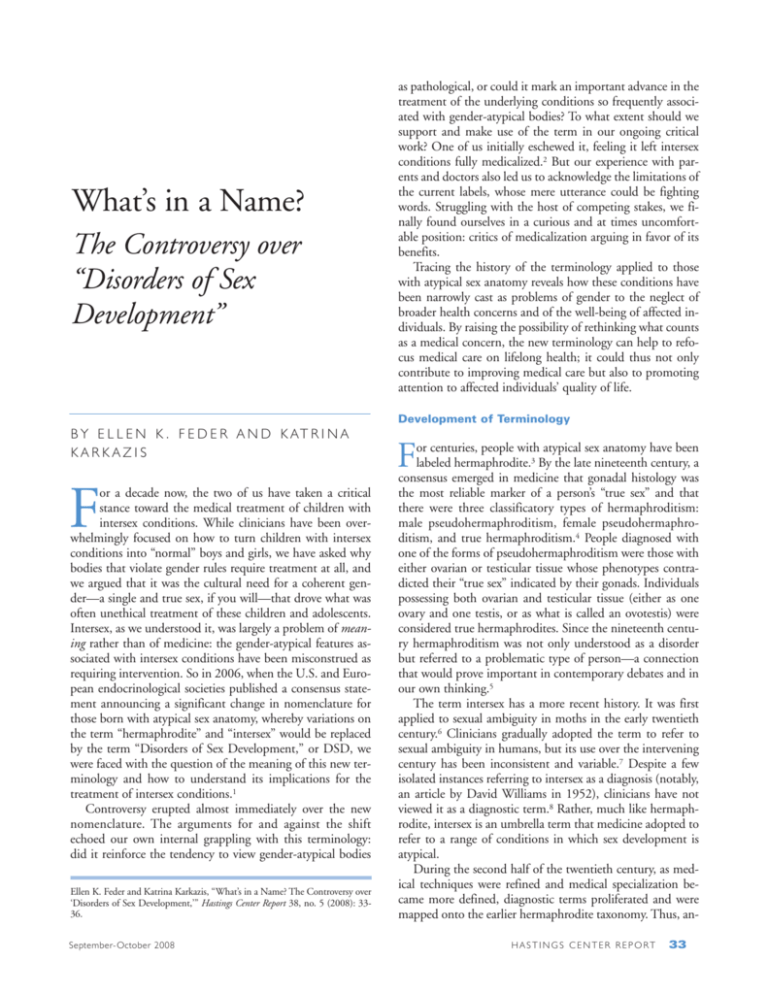
What’s in a Name?
The Controversy over
“Disorders of Sex
Development”
as pathological, or could it mark an important advance in the
treatment of the underlying conditions so frequently associated with gender-atypical bodies? To what extent should we
support and make use of the term in our ongoing critical
work? One of us initially eschewed it, feeling it left intersex
conditions fully medicalized.2 But our experience with parents and doctors also led us to acknowledge the limitations of
the current labels, whose mere utterance could be fighting
words. Struggling with the host of competing stakes, we finally found ourselves in a curious and at times uncomfortable position: critics of medicalization arguing in favor of its
benefits.
Tracing the history of the terminology applied to those
with atypical sex anatomy reveals how these conditions have
been narrowly cast as problems of gender to the neglect of
broader health concerns and of the well-being of affected individuals. By raising the possibility of rethinking what counts
as a medical concern, the new terminology can help to refocus medical care on lifelong health; it could thus not only
contribute to improving medical care but also to promoting
attention to affected individuals’ quality of life.
Development of Terminology
B Y E L L E N K . F E D E R A N D K AT R I N A
KARKAZIS
F
or a decade now, the two of us have taken a critical
stance toward the medical treatment of children with
intersex conditions. While clinicians have been overwhelmingly focused on how to turn children with intersex
conditions into “normal” boys and girls, we have asked why
bodies that violate gender rules require treatment at all, and
we argued that it was the cultural need for a coherent gender—a single and true sex, if you will—that drove what was
often unethical treatment of these children and adolescents.
Intersex, as we understood it, was largely a problem of meaning rather than of medicine: the gender-atypical features associated with intersex conditions have been misconstrued as
requiring intervention. So in 2006, when the U.S. and European endocrinological societies published a consensus statement announcing a significant change in nomenclature for
those born with atypical sex anatomy, whereby variations on
the term “hermaphrodite” and “intersex” would be replaced
by the term “Disorders of Sex Development,” or DSD, we
were faced with the question of the meaning of this new terminology and how to understand its implications for the
treatment of intersex conditions.1
Controversy erupted almost immediately over the new
nomenclature. The arguments for and against the shift
echoed our own internal grappling with this terminology:
did it reinforce the tendency to view gender-atypical bodies
Ellen K. Feder and Katrina Karkazis, “What’s in a Name? The Controversy over
‘Disorders of Sex Development,’” Hastings Center Report 38, no. 5 (2008): 3336.
September-October 2008
F
or centuries, people with atypical sex anatomy have been
labeled hermaphrodite.3 By the late nineteenth century, a
consensus emerged in medicine that gonadal histology was
the most reliable marker of a person’s “true sex” and that
there were three classificatory types of hermaphroditism:
male pseudohermaphroditism, female pseudohermaphroditism, and true hermaphroditism.4 People diagnosed with
one of the forms of pseudohermaphroditism were those with
either ovarian or testicular tissue whose phenotypes contradicted their “true sex” indicated by their gonads. Individuals
possessing both ovarian and testicular tissue (either as one
ovary and one testis, or as what is called an ovotestis) were
considered true hermaphrodites. Since the nineteenth century hermaphroditism was not only understood as a disorder
but referred to a problematic type of person—a connection
that would prove important in contemporary debates and in
our own thinking.5
The term intersex has a more recent history. It was first
applied to sexual ambiguity in moths in the early twentieth
century.6 Clinicians gradually adopted the term to refer to
sexual ambiguity in humans, but its use over the intervening
century has been inconsistent and variable.7 Despite a few
isolated instances referring to intersex as a diagnosis (notably,
an article by David Williams in 1952), clinicians have not
viewed it as a diagnostic term.8 Rather, much like hermaphrodite, intersex is an umbrella term that medicine adopted to
refer to a range of conditions in which sex development is
atypical.
During the second half of the twentieth century, as medical techniques were refined and medical specialization became more defined, diagnostic terms proliferated and were
mapped onto the earlier hermaphrodite taxonomy. Thus, anHASTINGS CENTER REPORT
33
drogen insensitivity syndrome, for example, was understood
more generally as a case of male pseudohermaphroditism.9 By
the end of the twentieth century, intersex was widely used in
the medical literature as a synonym for hermaphrodite, and
the older taxonomy based on hermaphroditism and the newer
diagnoses of specific conditions coexisted, if at times uneasily.
Despite the variability of the terms, one thing remained consistent: intersex was understood to denote kinds of people
who violated prevailing cultural understandings of male and
female bodies, and for whom physicians sought to provide a
coherent gender.
The use of the term intersex became newly contentious beginning in the 1990s, when activists appropriated the term for
their own use. Newly politicized
and no longer restricted to medicine, intersex came to mean
many things to different people,
fueling widespread disagreement
over what diagnoses—and thus
who—counted as intersex. Because activists were interested in
bringing together people who
shared similar treatment and life
experiences, they made use of
the term intersex to refer to any
condition in which reproductive
or sexual anatomy does not conform to typical understandings
of male and female. Thus, they
often included conditions such
as Turner syndrome and hypospadias that clinicians would
not locate within the older taxonomy.10 Some activists further
embraced intersex as an identity, likening it to any of a number of other categories of gender identity that one can claim.
The expansion of conditions considered intersex drew criticism from clinicians and parents, among others, who variously felt the term intersex referred only to conditions for
which genitalia are “ambiguous,” or only to those conditions
for which chromosomal type and phenotype are discordant.
Still others held that the term did not refer to conditions in
which the genitals may be atypical but for which the brain has
had gender-typical hormonal exposure.11 Moreover, many
people—and perhaps the majority of parents of people affected with these conditions—resisted the imputation of identity
associated with intersex. Not surprisingly, many parents and
clinicians found the term’s connotation that the affected person is neither male nor female (or is both male and female)
deeply objectionable. They felt it did not apply to those conditions for which gender assignment is straightforward or to
those people who had undergone genital surgery (whose “intersexuality” had been “corrected”). The term intersex has
been viewed as stigmatizing by many doctors and parents and
by some of the individuals who have these conditions. For this
reason, doctors have largely avoided using the term in the
clinical setting despite its widespread use in the medical literature over the last fifty years.12
Over time, people began to recognize a need to change aspects of medical care provided to people with intersex conditions, such as adopting a more cautious approach to genital
surgery and providing psychosocial support for families. As
this trend took hold, and as activists and advocates became increasingly interested in working in partnership with parents
and doctors toward this end, it became clear that the existing
nomenclature—and particularly the term intersex—presented
a barrier to conversation, collaboration, and, hence, the improvement of care. Many took
intersex to be a politicized term
identified with radical gender
activists who advocated deferral
of sex assignment and opposed
early genital or gonadal surgeries. Perhaps most importantly,
advocates for improved care—
who were trying to convey the
message that questions of gender should not be the primary
focus of medical care—came to
believe that the term intersex actually reinforced and refocused
conversations on those very
questions.13
If “DSD” promotes focus
on the medical issues
associated with intersex
conditions, displacing
concerns with gender
identity, then it may bring
welcome clarification.
34 H A S T I N G S C E N T E R R E P O R T
Implications of Continuing
Medicalization
T
he new nomenclature aims
to circumvent the fraught
history of the terms hermaphrodite and intersex. The use of these terms to identify kinds of
people, rather than individuals with conditions that could
have profound health consequences, is not only inconsistent
with contemporary medical nomenclature but appears to have
helped shape unethical aspects of treatment characterizing
medical management since at least the 1950s.14 Resistance to
the term has come most forcefully from those who experience
the introduction of DSD as yet another instance of medical
“pathologization” of their bodies and their selves.15 David
Cameron’s powerful and succinct declaration—“I am a person, not a disorder”—encapsulates the aim of intersex activism since its beginning.16 Cameron’s is an entirely apt response to the position that intersex conditions can be corrected or ameliorated through cosmetic genital surgery, hormone
replacement, and secrecy about bodily traits and their treatment—a position that was intended to minimize the shame
and stigma associated with gender-atypical bodies but that effectively promoted shame and stigma. If DSD merely replaces
intersex, then it serves only to reinforce a history of medicalization that has brought much physical and emotional pain.
For those who have refused to identify as intersex, however,
September-October 2008
the term DSD brings a welcome clarification that theirs is a
medical condition, not an identity.
Both the resistance to and the enthusiastic embrace of the
new nomenclature underscore the fact that intersex conditions have been understood for more than half a century as
“disorders like no other.”17 Doctors have thereby justified
treatment of these conditions in ways that defy accepted medical practice and that violate long-established principles of
bioethics. The shift from variations on hermaphroditism and
intersex to DSD and clinically specific diagnoses may be understood not as a politically correct attempt to replace stigmatized terms with less stigmatized terms, but as an effort to replace terminology that has shaped harmful treatment practices with terminology consistent with medicine that, however problematically, regards all deviations from a norm it itself
defines as being “disorders.”
In place of the pathologizing language of disorder, some
have suggested the terms “variation” or “divergence.”18 These
alternatives rightly indicate that differences of anatomy
should be regarded no differently than other inconsequential
anatomical differences—eye color, for example. Although
these alternatives are intended to depathologize gender atypicality, their narrow concern with establishing atypical anatomy as acceptable continues to mark differences of gender and
genitalia as the primary problem of intersex conditions. This
strategy may trivialize the genuine medical needs of those
with atypical anatomies, whether in the neonatal period (as
with congenital adrenal hyperplasia) or across the lifespan (as
with many other conditions). It may also privilege anatomical
difference over and against these needs. The new nomenclature brings with it the possibility of focusing on genuine medical needs while—and this must be the ongoing challenge—
understanding different anatomies that are symptomatic of
these conditions as mere variations. Viewed in this way, the
change in nomenclature offers the possibility that intersex
conditions can be transformed from “disorders like no other”
to “disorders like many others,” and so must be treated both
clinically and ethically in ways that are consistent with other
medical conditions.
Identity and Disorder
P
erhaps ironically, what makes intersex conditions like no
other is that they have been treated, both by physicians
aiming to “correct” them and by activists resisting these same
practices, as an issue of identity. If the change in nomenclature can promote the important development of attention to
the genuine medical issues associated with intersex conditions
and so displace the concerns with gender identity, then intersex can be counted among the many disorders for which the
terms “normal” and “abnormal” are taken to mark differences—some consequential, others less so—in the functioning of human bodies.
Changing the nomenclature is not a panacea: there remain
significant problems in lumping together widely disparate
conditions whose only common feature is that they produce
September-October 2008
gender-atypical phenotypes. Thus, the introduction of DSD
marks another moment in the history of medicalizing bodies
that defy the norms of so-called natural sex development. Debate over the nomenclature has focused overwhelmingly on
how best to characterize an umbrella term for these conditions, but this focus is misplaced. The critical move is the recommendation that DSD be used together with a system
based on clinically descriptive terms—for example, “androgen
insensitivity syndrome” and “congenital adrenal hyperplasia.”19 It would be naive to think that the change in nomenclature can destigmatize gender atypicality. It is the latter
shift—that is, a focus on the specific disorders in question—
that holds immediate promise for demedicalizing aspects of
the condition that have been improperly pathologized.
Despite the rancor provoked by the debate over the new
nomenclature, we should not lose sight of the fact that almost
everyone involved in this discussion would agree on matters
concerning care for those diagnosed with intersex conditions.
That there are grave problems with the history of treatment,
and an urgent need to secure appropriate medical care both in
the neonatal period and across the lifespan, is uncontroversial.
We must grant that while there is no terminology that can
eradicate the stigma of atypical anatomies, nomenclature that
situates conditions in the “usual” way of medicine—as matters of health rather than identity—can certainly help to correct many of the gross wrongs of the past.
1. P.A. Lee et al., “Consensus Statement on Management of Intersex
Disorders, International Consensus Conference on Intersex,” Pediatrics
118, no. 2 (2006): e488-500.
2. K. Karkazis, Fixing Sex: Intersex, Medical Authority, and Lived Experience (Durham, N.C.: Duke University Press, 2008).
3. L. Daston and K. Park, “The Hermaphrodite and the Orders of
Nature: Sexual Ambiguity in Early Modern France,” GLQ: A Journal of
Gay and Lesbian Studies 1 (1995): 419-38; A. Dreger, Hermaphrodites
and the Medical Invention of Sex (Cambridge, Mass.: Harvard University Press, 1998).
4. Dreger, Hermaphrodites and the Medical Invention of Sex.
5. Ibid.
6. R. Goldschmidt, “Intersexuality and the Endocrine Aspect of Sex,”
Endocrinology 1 (1917): 433-56.
7. The term “intersex” had been in use for some time but had been
used to refer to what today we would understand as homosexuality and
bisexuality.
8. D.I. Williams, “The Diagnosis of Intersex,” British Medical Journal
1, no. 4771 (1952): 1264-70. “Intersex” occurs nowhere in ICD9 or
ICD10, the current and forthcoming versions of the International Statistical Classification of Diseases and Related Health Problems. Rather,
“752.7 Indeterminate sex and pseudohermaphroditism” is an umbrella
classification.
9. By the end of the twentieth century, dozens of diagnoses were
classed in the hermaphrodite taxonomy; see M.M. Grumbach, F.A.
Conte, and I.A. Hughes, “Disorders of Sex Differentiation,” Williams
Textbook of Endocrinology, tenth ed., ed. P.R. Larsen et al. (Philadelphia,
Penn.: W.B. Saunders, 2002).
10. Intersex Society of North America, “Frequently Asked Questions:
What Is Intersex?” http://www.isna.org/faq/what_is_intersex; accessed
March 26, 2008.
HASTINGS CENTER REPORT
35
11. W.G. Reiner, “Gender Identity and Sex-of-Rearing in Children
with Disorders of Sexual Differentiation,” Journal of Pediatric Endocrinology and Metabolism 18, no. 6 (2005): 549-53.
12. S. Kessler, Lessons from the Intersexed (New Brunswick, N.J.: Rutgers University Press, 1998); Karkazis, Fixing Sex.
13. The change in nomenclature emerged out of a confluence of
events occurring in 2005. In response to the controversy provoked by
the use of the term intersex, the Intersex Society of North America
(ISNA), an advocacy group, argued for new terminology that it sought
to introduce in parent handbooks and clinical guidelines it was preparing (see also A. Dreger et al., “Changing the Nomenclature/Taxonomy
for Intersex: A Scientific and Clinical Rationale,” Journal of Pediatric Endocrinology and Metabolism 18 (2005): 729-33). During this same period, the U.S. and European endocrinological societies convened a meeting to revisit the standard of care for intersex, providing an opportunity
for advocates of the change in nomenclature to argue for a formal
change and for announcing it in a consensus statement. When those at
the meeting settled on “Disorders of Sex Development,” ISNA followed
that usage for the handbook (see Consortium on the Management of
Disorders of Sex Development, “Clinical Guidelines for the Management of Disorders of Sex Development in Childhood,” 2006, www.
dsdguidelines.org/clinical, and “Handbook for Parents,” 2006, www.
dsdguidelines.org/parents).
14. Kessler, Lessons from the Intersexed; Karkazis, Fixing Sex.
15. See letters to the editor in response to the consensus statement
published by the Consortium on the Management of Disorders of Sex
Development, http://adc.bmj.com/cgi/eletters/adc.2006.098319v1.
16. D. Cameron, personal communication to Katrina Karkazis.
17. E. Feder, “Imperatives of Normality: From ‘Intersex’ to ‘Disorders
of Sex Development,’” GLQ: A Journal of Gay and Lesbian Studies, forthcoming.
18. M. Diamond and H.G. Beh, “Variations of Sex Development instead of Disorders of Sex Development,” letter to the editor, British
Medical
Journal
(2006),
http://adc.bmj.com/cgi/eletters/
adc.2006.098319v1#2460; E. Reis, “Divergence or Disorder? The Politics of Naming Intersex,” Perspectives in Biology and Medicine 50, no. 4
(2007): 535-43.
19. I.A. Hughes et al., “Consensus Statement on Management of Intersex Disorders,” Archives of Disease in Childhood 91, no. 7 (2006): 55463.
Web of Care:
How Will the Electronic
Medical Record Change
Medicine?
BY JOSEPH J. FINS
S
everal weeks ago, fifteen of my primary care-internist
colleagues and I sat in a midtown skyscraper in a classroom fitted with a laptop computer for each of us. Coffee cups in hand, we embarked upon a two-hour class—the
first installment of a ten-hour course—to learn to use a multispecialty electronic medical record (EMR).
The EMR our medical center has decided to launch is elegant, with lots of pop-ups, color-coding, and an amazing ability to collect and generate data. Our instructors pointed out
that the new system was more than just a computer to write
notes or order prescriptions. Our practice has had that capability for years.
No, this new system was different. It was a medical information superhighway. It connected you with colleagues
throughout the medical center by means of a shared medical
record. Between sips of coffee, we were told of the new system’s capabilities: If you want to know about your patient’s
last visit to the urologist or send a pre-op clearance note to his
cardiac surgeon, your colleague is but a click away. Order a
drug that is incompatible with the patient’s medication list,
and the EMR will warn you away from your choice and steer
you clear of a pharmacologic mismatch. Beyond its capability
to promote safety, it also can facilitate outcomes research.
Although I was none too thrilled to trudge downtown for
training, I must admit that typing up a mock patient visit on
the computer was fun. Since it is not altogether different from
ordering a book on Amazon or searching UpToDate for medical information, it was not entirely unfamiliar, but it was still
Joseph J. Fins, “Web of Care: How Will the Electronic Medical Record Change
Medicine?” Hastings Center Report 38, no. 5 (2008): 36-38.
36 H A S T I N G S C E N T E R R E P O R T
September-October 2008

